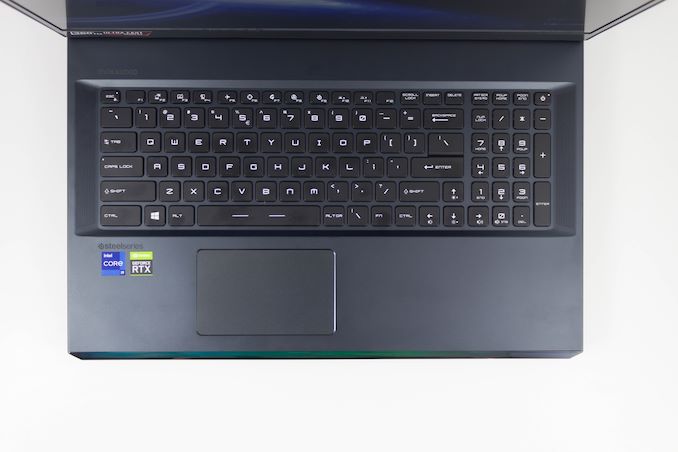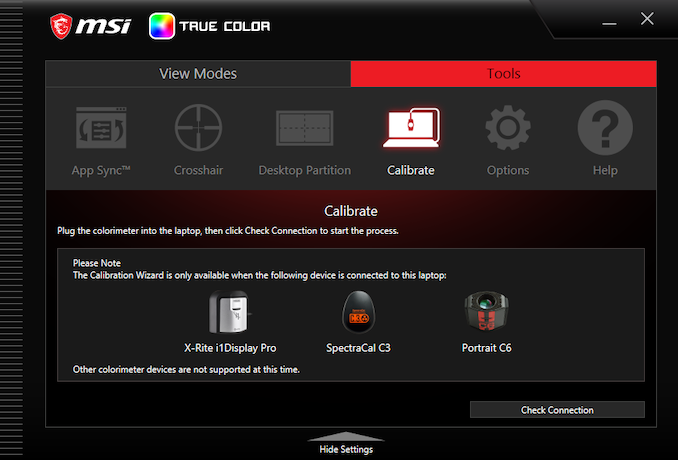Intel Alder Lake-H Core i9-12900HK Review: MSI's Raider GE76 Goes Hybrid
by Brett Howse on January 25, 2022 9:00 AM EST- Posted in
- CPUs
- Intel
- MSI
- Laptops
- Alder Lake
- GE76 Raider
- 12th Gen Core
- Alder Lake-H
The Test Platform: MSI's Raider GE76
For 2022, MSI has not updated the underlying chassis for the new Alder Lake product, and as such our review of the GE76 Raider from 2021 with Tiger Lake does not fundamentally change in terms of chassis design and cooling. This is still a big, relatively heavy desktop-replacement system. It features an aluminum surface where you will be touching it, and a polycarbonate base.
MSI generally builds a very solid product, and for 2022 they have upgraded the cooling with a new phase-change thermal pad which allows them to wick heat away from the processor and GPU quicker, without some of the negatives of a pure-liquid thermal compound and crystallization that can occur.
The system offers a per-key RGB backlit keyboard from SteelSeries. There is a 1080p webcam as well, and the system now offers an AI-based setting to let the system automatically switch the power levels for the user without having to manually do it, although the manual options are still there. MSI has updated their Silent mode to now leverage the microphones on the system to match the noise floor of the room, which lets them extract more power from the processor, and more fan speed, while still being inaudible.
The Raider GE76 offers lots of connectivity, including a single Thunderbolt 4 port, an additional USB Type-C port, and several USB Type-A ports. There is also a SD card reader which is still convenient when uploading from a camera.
The system offers Wi-Fi 6E support thanks to the Killer AX1675 Wi-Fi adapter, and also includes the Killer E3100G 2.5 Gbps Ethernet adapter.
MSI offers a range of display options, with a 1920x1080 144 Hz panel on their least expensive Raider GE76, a 1920x1080 360 Hz panel which is in the sampled unit, a 2560x1440 240 Hz panel, and a 3840x2160 120 Hz offering.
On our Tiger Lake sample we reviewed late last year, the display accuracy was not up to par with typical MSI offerings. Thankfully that appears to have been a one-off, which we do see from time to time even on devices that are hardware calibrated at the factory. MSI does allow you to use a built-in tool to calibrate the display, but you do need a supported colorimeter.
Thanks to Portrait Displays for the use of their Calman software so we can continue to accurately measure displays for our reviews.
As you can see, the color accuracy of this sample is much improved over the Tiger Lake model from last year that we received.
Brightness and Contrast



Grayscale

Gamut

Saturation

Gretag Macbeth

The MSI Raider GE76 is a fantastic test bed for Intel's Alder Lake system, with a powerful cooling system, and a great build quality.




















153 Comments
View All Comments
lmcd - Wednesday, January 26, 2022 - link
Ryzen 6000 does not exist as of 1/26/2022.Your analogy is awful but ironically correct -- comparable European/Japanese sports cars also get horrifying mileage, and the performance gap is in the nonsense territory with fanboys on either side debating what the immeasurable differences mean.
Spunjji - Thursday, January 27, 2022 - link
👆PeachNCream - Friday, January 28, 2022 - link
Its always funny to watch people.try to compare computers to cars. That literally happens all of the time in the tech industry and rarely fits the situation because, well obviously, computers are not cars.TheinsanegamerN - Friday, January 28, 2022 - link
It's always funny to watch people complain about car comparisons simply because "well cars and computers are different" without any other context. Tells me you have no real counterargument.cowymtber - Tuesday, January 25, 2022 - link
Tim from HUB...Do your power normalization magic, and release the demons!Timoo - Tuesday, January 25, 2022 - link
I haven't really seen the comment floating around yet.SInce Intel got bumped by Apple, could this design be their result out of a failed collaboration?
I mean, they planned to bring this design, say, 3 to 5 years ago, for Apple MacBooks etc.
But Apple -meanwhile- was thinking they could do better by themselves?
So, now Intel had their Big.Little design, in co-op with Apple, and nowhere to go but to the x86 market in full-force. Not backed by the idea that they would also end up in the Apple store...
Brett Howse - Tuesday, January 25, 2022 - link
Not likely. Apple is a big customer, but not Intel's biggest.Timoo - Tuesday, January 25, 2022 - link
Ok, I just found it kind of "coincidential" that a year after we got the news Apple has dumped Intel for their own M1, Intel comes with a "similar" design. Which must have been in development already since -say- 2016 or 2017.Maybe I have to search it in the area of thinking along with the ARM train, where Big.Little is normal, and Intel realising they have Big.Little for x86 laying around (Atom + Core). I just got the impression that it was Apple who might have triggered this idea with Intel...
But then again; that would bring a lot of Queensize Drama to this release (the failed Intel-Apple chip). And I love drama. So I am biased, presumably :-D
Thanks for your reply!
IntelUser2000 - Wednesday, January 26, 2022 - link
No, the hybrid combo was first presented by Intel back in 2005 or so by then-CTO Justin Rattner.https://images.anandtech.com/reviews/tradeshows/ID...
It might have been first at Intel if they didn't have a braindead management and CEO and executed on 10nm.
lmcd - Wednesday, January 26, 2022 - link
Intel probably started work closer to 2012. The roadmap for Atom has been converging toward serving as a desktop/laptop small core since the smartphone Atoms got canned and tablet got deprioritized. By no coincidence, that happened when Apple slammed every smartphone chip with the A7, which was also Intel's public wakeup that Apple could easily reach laptop performance on a quick timeline.